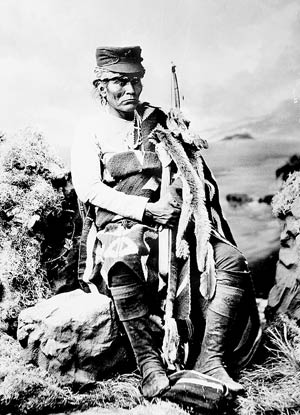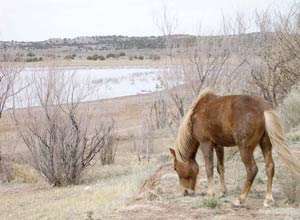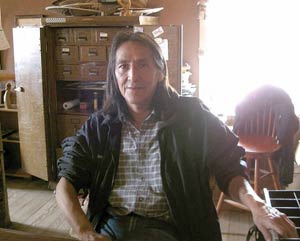At the crossroads of health and commerce
Independent of the reservation, Ganado prospered
By Cindy Yurth
Tséyi' Bureau
GANADO, Ariz, April 11, 2013
(Editor's note: In an effort to chronicle the beauty and diversity of the Navajo Nation, as well as its issues, the Navajo Times has committed to visiting all 110 chapters in alphabetical order. This is the 30th in the series.)




(Times photo — Cindy Yurth)
SECOND FROM THE TOP: Like Manuelito, Ganado Mucho (known simply by his clan name, Totsonii Hastiin, in Navajo) was one of the "ricos" — wealthy Navajos who won respect among their people and became leaders. Originally known as Pueblo Colorado, the settlement around Hubbell Trading Post was rechristened "Ganado" by the great chief's friend, trader Lorenzo Hubbell, when the U.S. Postal Service set up a post office there and needed an official name for the town. TBHIRD FROM THE TOP: A horse enjoys the solitude of Ganado Lake last Thursday. Although the lake is an open secret among fishermen, no attempt has been made to cater to them with a campground or bait shop. FOURTH FROMT HE TOP: With trader Steve Pickle retiring this month, his associate trader Edison Eskeets becomes the first Navajo to run the trading post at Hubbell Trading Post National Historic Site. Originally from Springstead, N.M., Eskeets worked at Northern Arizona Museum in Flagstaff before moving back to New Mexico and eventually making his way to Hubbell, where he has been since 2007.
T he local ruin Lok'aa Niteel (Wide Reeds) attests that people have been living along the Pueblo Colorado Wash since Anasazi times, but Ganado really took off after the band of Ganado Mucho (Spanish for "Many Cattle") followed the chief here after the Long Walk.
The area was not part of the original reservation created by the Treaty of 1868, but that did not bother Ganado Mucho, known to his followers as Totsonii Hastiin ("Big Water Man").
If anything, it gave the chief and his band the freedom to do as they wished without constantly consulting the Indian agent at Fort Defiance. They established farms and began building up their herds.
Traders followed the Diné settlers. William Leonard had a cluster of adobe buildings at the site of the present Hubbell Trading Post, and Charlie Hubbell had a post south of Ganado Lake.
Things went on like this, with the impoverished Navajos attempting to build back up to their former prosperity, when an event took place that became known as the Navajo Witch Purge.
In 1878, up to 40 people in the Ganado area were accused of being witches and killed — one of them right on the doorstep of Charlie Hubbell's trading post.
Knowing that the Navajo would never again enter that building, Charlie's brother, John Lorenzo Hubbell, bought Leonard's operation, eventually building it into not only a trading post but a way station and nearly self-sufficient farm that attracted politicians and artists from all over the country.
Hubbell and Ganado Mucho were friends, and when the U.S. Post Office set up shop in the post, it was Hubbell who convinced the government to call the town "Ganado."
Hubbell loved the deep red dye used by the local rug dealers and encouraged its use, fostering the style now known as "Ganado Red."
Presbyterian missionaries, attracted by the fertile flood plain and Hubbell's apparent good relationship with the Navajos, came in the early 1900s, building a church and a school. A hospital followed in 1911, and in 1930, Dr. Clarence Salsbury founded the country's first nursing school for Native American women.
According to the nomination for Sage Memorial Hospital School of Nursing's registry on the National Register of Historic Places (which was granted in 2008), many Anglos at the time did not believe minority women had the capacity to become good nurses. Minority students had a hard time getting into nursing schools, or any colleges for that matter.
The Ganado school proved them wrong, attracting students from 50 American tribes and several foreign countries. The school developed such a good reputation that white students were soon clamoring to get in, but Salsbury turned them away, pointing out that they could get their education anywhere, but his was the only such institution for non-whites. The school operated until 1951.
Today, the school is gone but Navajo Technical College and Diné College both have branches here. Both the hospital and the trading post are still operating.
Although Sage's historic stone buildings are picturesque, they're in bad shape and hard to retrofit for modern conveniences. A new hospital is on the drawing board.
Hubbell Trading post, sold to the National Park Service by Hubbell's daughter in 1967, is now a National Historic Site whose acting superintendent, Stanley Belinte, is the first Navajo in that position.
The trading post is still operating, and the main trader, Steve Pickle, has announced his retirement. The heir apparent, his assistant Edison Eskeets, is also Navajo.
And Ganado continues on as a center of commerce.
At the junction of two main highways, U.S. 191 and Arizona 264, it hosts three gas stations with convenience stores. The community is trying to lure in a full-fledged supermarket, revealed the chapter's Accounts Maintenance Specialist Lela Sangster, and has withdrawn land across from the post office for other businesses.
Ty's Tire Shop, established in 2010, is prospering, and there a couple of non-emergency transport companies.
Apache County District II is headquartered here, and according to Sangster, "works very well with the chapter." The two entities are looking at collaborating on a new senior citizens center and a veterans memorial.
Ganado High School and its stadium and aquatic center offer another focal point for the community.
An electrical line is in the works in the Burnside area.
At the junction of two main highways, "We can get wherever we want to go," said the chapter's receptionist, Eva Louis.
Based on this industrious chapter's history, that's true figuratively as well.
Ganado at a Glance
Name — After local headman Ganado Mucho ("Many Cattle"), known in Navajo as Totsonii Hastiin ("Big Water Man"). Navajos also call the community Lok'aa Niteel ("Wide Reeds") after a local ruin.
Population — 1,210 at the 2010 Census
Land area — 8.9 square miles
Features — Hubbell Trading Post National Historic Site, Sage Memorial Hospital, Ganado Lake, intersection of two main highways
Problems — traffic accidents, substance abuse

